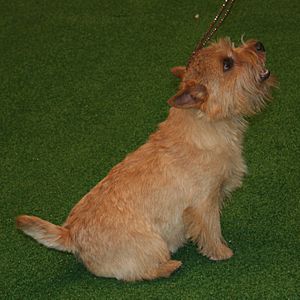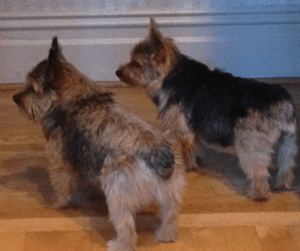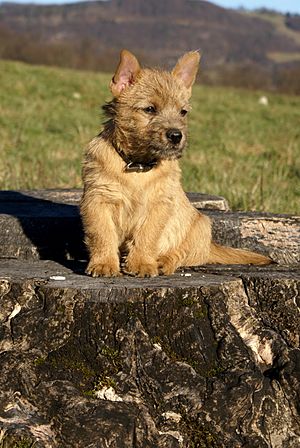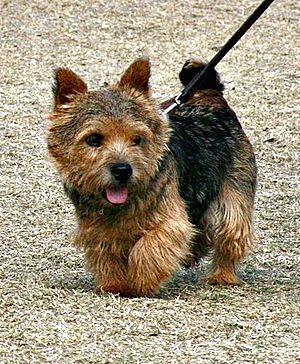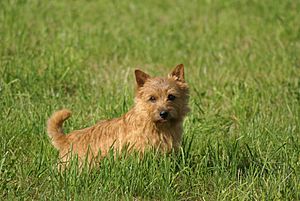Norwich Terrier facts for kids
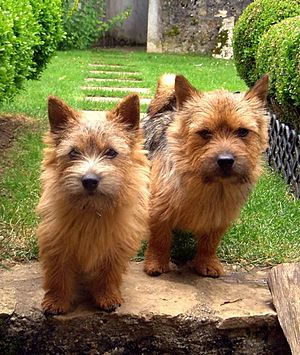
Red (left) and Black & Tan (right) Norwich Terriers
|
|||||||||||||||||||||||||||||
| Origin | United Kingdom | ||||||||||||||||||||||||||||
|---|---|---|---|---|---|---|---|---|---|---|---|---|---|---|---|---|---|---|---|---|---|---|---|---|---|---|---|---|---|
|
|||||||||||||||||||||||||||||
|
|||||||||||||||||||||||||||||
| Domestic dog (Canis lupus familiaris) | |||||||||||||||||||||||||||||
The Norwich Terrier is a type of dog that first came from the United Kingdom. These dogs were originally bred to hunt small rodents like mice and rats. Today, Norwich Terriers are mostly known as friendly companion dogs. They love to be with their families.
These terriers are among the smallest of their kind. They are usually healthy dogs. However, they are quite rare. This is partly because they have very small litters of puppies. Sometimes, the mother dog needs a special surgery called a Cesarean section to give birth. The Norfolk Terrier is a very similar breed, but it has floppy ears instead of pointy ones. The Norwich Terrier was officially recognized in England in 1932. For almost a century, they have been loyal and hardworking pets around the world.
Contents
About the Norwich Terrier
What do Norwich Terriers Look Like?
Norwich Terriers are one of the smallest working terriers. They usually weigh about 5 to 5.5 kilograms (11-12 pounds). They stand about 24 to 25.5 centimeters (9-10 inches) tall at the shoulder. They have pointy ears and a special double coat. This coat has a hard, wiry outer layer and a soft, warm undercoat.
Their coats come in several colors. These include red, tan, wheaten, black and tan, and grizzle. Grizzle means a mix of red and black hairs. Their tails can be different lengths, from 5 to 20 centimeters (2 to 8 inches). A wagging tail is a good sign that a Norwich Terrier is happy!
What is a Norwich Terrier's Personality Like?
These small dogs are very strong and brave. They are also smart and loving pets. Norwich Terriers can be quite sure of themselves. However, they are usually not aggressive or shy. They have a lot of energy and enjoy an active life. They also love to eat and will try to snack on anything tasty!
Norwich Terriers want to please their owners. But they also have their own ideas about things. They don't like being scolded. These dogs should not live outside in a kennel. They really enjoy being close to their human families. Norwich Terriers usually don't bark a lot without reason. But they will bark to let you know if a stranger is coming. Once they see there's no danger, they quickly become friendly. They are generally good with children. If they meet other pets as puppies, they can usually live together peacefully. However, always be careful around small rodent pets. The terrier's hunting instinct might make them think of them as prey.
Norwich Terrier Health
Common Health Issues
Norwich Terriers typically live for 13 to 13.5 years. They are considered a healthy dog breed. Good breeders do special genetic health tests. This helps to reduce the chances of puppies having certain health problems.
While Norwich Terriers are healthy, some issues can happen. For example, some dogs might get cataracts, which affect their eyes. Other issues that have been reported include epilepsy (seizures) and problems with their windpipes. They can also have issues with their kneecaps (called luxating patellas) or hips (called hip dysplasia). Heart problems like mitral valve disease can also occur. Some dogs might have liver problems or skin allergies.
Breathing Problems
Some Norwich Terriers can have breathing problems. This is called Upper Airway Syndrome (UAS). It includes different issues that affect how a dog breathes. For example, they might have a soft palate that is too long or too short. Their windpipes might be too narrow or collapse easily. Their nose passages might be too small. These issues can make their breathing sound raspy or wet. It's thought that dogs with shorter noses might have more of these problems.
Vaccinations and Breeding
Like all dogs, Norwich Terriers can sometimes react to rabies vaccinations. This reaction is called RVI-ID. It's not usually serious but can cause dark spots on their ears or lumps near the injection site. If caught early, it can be treated.
Norwich Terriers usually have small litters, with only 1 to 3 puppies. Female dogs are usually bred between 2 and 6 years old. This is after they have had all their health tests. Because these puppies are rare and special, they can be quite expensive. Sadly, this has sometimes led to people selling fake Norwich Terriers. They might sell other breeds or mixed puppies as purebred Norwich Terriers.
Caring for a Norwich Terrier
Exercise Needs
Norwich Terriers are strong and active dogs. They were originally bred to hunt small animals and to keep up with farmers on horseback. So, they need a good daily walk to stay healthy and happy. They love activities like Earthdog competitions, where they can dig and explore. They also do well in dog sports like Agility and Flyball.
These dogs were bred to work hard. They need at least an hour of real activity every day. This could be a long walk, a run, or a training session. Like any hardworking dog, they love to play games as a reward. Norwich Terriers are great at fetching sticks and running long distances. They might even enjoy a swim if supervised. They are very loyal to their owners and love to do fun activities with them.
Grooming Their Coat
The Norwich Terrier has two layers of fur. The topcoat is rough and wiry, and the undercoat is soft and warm. To keep their coat healthy, it's best to comb it daily or at least once a week. This removes loose hairs and stops the coat from getting tangled.
To properly care for a Norwich Terrier's coat, you need to "strip" it. This means gently pulling out the oldest hairs by hand or with a special comb. Stripping helps the coat look its best and keeps the dog's skin healthy. Ideally, owners hand-strip the coat regularly. This creates a "rolling" coat, where hairs of all lengths are growing. This is easier on the dog's skin and makes grooming sessions shorter. At the very least, the coat should be stripped once in the autumn and once in the spring. Cutting or clipping their fur can change its natural color and texture.
Tail Docking
Tail docking is when a dog's tail is shortened, usually when they are very young. In the past, tails were docked in the UK to avoid taxes on working dogs. Today, some people believe that working Norwich Terriers should have docked tails. They think it lowers the risk of tail injury if the dog goes into small holes. Some also think a docked tail makes the dog look nicer.
However, many people are against tail docking. They point out that a dog's tail is very important for communication. Dogs use their tails to "talk" to other dogs and people. A docked tail can make this harder. The tail also helps a dog balance when moving over rough ground or turning quickly. Many countries have banned tail docking, including Norway, Sweden, Cyprus, Greece, Luxembourg, and Switzerland. In the United Kingdom, it's only allowed for working dogs, not for pets or show dogs.
Norwich Terrier Reproduction
Norwich Terriers can be challenging to breed. Many female dogs need a Cesarean section (C-section) to deliver their puppies. In North America, the average litter size is only two puppies. This means not many Norwich Terrier puppies are born each year. Some breeding lines do have larger litters. You can often find this information in the records of kennel clubs.
History of the Norwich Terrier
The Norwich Terrier breed has been around since at least the late 1800s. They were working dogs in a part of England called East Anglia. These dogs were great at catching rats in stables. They also helped hunters by chasing foxes out of their dens. And they were loving family pets. The Norwich Terrier was even a mascot for students at Cambridge University.
Small red terriers, possibly related to Irish Terriers, lived in this area since the 1860s. These might be the ancestors of the Norwich Terrier. Another possible ancestor is the Trumpington Terrier, which no longer exists. In its early days, the Norwich Terrier was also known as the Jones Terrier or the Cantab Terrier.
When the Norwich Terrier was first recognized in dog shows in 1932, both pointy-eared and floppy-eared puppies were allowed. Floppy ears were sometimes "cropped" (made pointy) until this became illegal. This led to a big discussion about whether floppy-eared dogs should be allowed in shows. People wondered if the only difference was the ears, or if there were other differences in personality or body shape.
Starting in the 1930s, breeders worked to make the two types more distinct. While Norwich and Norfolk Terriers were bred together for some years, today they are definitely two separate breeds. In fact, some old records suggest they were separate breeds even before they were interbred. The Kennel Club recognized the floppy-eared variety as a separate breed, the Norfolk Terrier, in 1964. Other kennel clubs, like the American Kennel Club, did the same in 1979. Before that, they were just called Norwich Terriers with "prick ears" (P.E.) or "drop ears" (D.E.).
See also
 In Spanish: Terrier de Norwich para niños
In Spanish: Terrier de Norwich para niños


